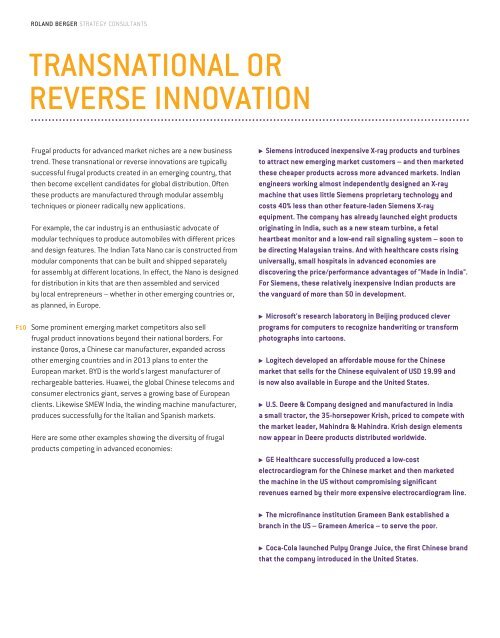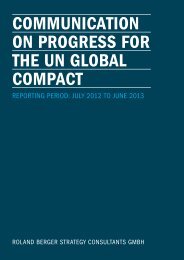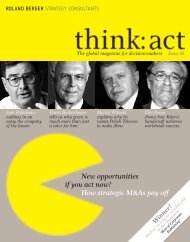PDF, 2492 KB - Roland Berger Strategy Consultants
PDF, 2492 KB - Roland Berger Strategy Consultants
PDF, 2492 KB - Roland Berger Strategy Consultants
- No tags were found...
Create successful ePaper yourself
Turn your PDF publications into a flip-book with our unique Google optimized e-Paper software.
<strong>Roland</strong> <strong>Berger</strong> <strong>Strategy</strong> <strong>Consultants</strong>Transnational orreverse innovationf10Frugal products for advanced market niches are a new businesstrend. These transnational or reverse innovations are typicallysuccessful frugal products created in an emerging country, thatthen become excellent candidates for global distribution. Oftenthese products are manufactured through modular assemblytechniques or pioneer radically new applications.For example, the car industry is an enthusiastic advocate ofmodular techniques to produce automobiles with different pricesand design features. The Indian Tata Nano car is constructed frommodular components that can be built and shipped separatelyfor assembly at different locations. In effect, the Nano is designedfor distribution in kits that are then assembled and servicedby local entrepreneurs – whether in other emerging countries or,as planned, in Europe.Some prominent emerging market competitors also sellfrugal product innovations beyond their national borders. Forinstance Qoros, a Chinese car manufacturer, expanded acrossother emerging countries and in 2013 plans to enter theEuropean market. BYD is the world's largest manufacturer ofre charge able batteries. Huawei, the global Chinese telecoms andconsumer electronics giant, serves a growing base of Europeanclients. Likewise SMEW India, the winding machine manufacturer,produces successfully for the Italian and Spanish markets.Here are some other examples showing the diversity of frugalproducts competing in advanced economies:Siemens introduced inexpensive X-ray products and turbinesto attract new emerging market customers – and then marketedthese cheaper products across more advanced markets. Indianengineers working almost independently designed an X-raymachine that uses little Siemens proprietary technology andcosts 40% less than other feature-laden Siemens X-rayequipment. The company has already launched eight productsoriginating in India, such as a new steam turbine, a fetalheartbeat monitor and a low-end rail signaling system – soon tobe directing Malaysian trains. And with healthcare costs risinguniversally, small hospitals in advanced economies arediscovering the price/performance advantages of "Made in India".For Siemens, these relatively inexpensive Indian products arethe vanguard of more than 50 in development.Microsoft's research laboratory in Beijing produced cleverprograms for computers to recognize handwriting or transformphotographs into cartoons.Logitech developed an affordable mouse for the Chinesemarket that sells for the Chinese equivalent of USD 19.99 andis now also available in Europe and the United States.U.S. Deere & Company designed and manufactured in Indiaa small tractor, the 35-horsepower Krish, priced to compete withthe market leader, Mahindra & Mahindra. Krish design elementsnow appear in Deere products distributed worldwide.GE Healthcare successfully produced a low-costelectrocardiogram for the Chinese market and then marketedthe machine in the US without compromising significantrevenues earned by their more expensive electrocardiogram line.The microfinance institution Grameen Bank established abranch in the US – Grameen America – to serve the poor.Coca-Cola launched Pulpy Orange Juice, the first Chinese brandthat the company introduced in the United States.
















